By running a survey about the religiousness of students in Germany and Turkey, the impact on the present-bias parameter is analysed. Highly religious people suffer less present-bias problems than non-highly religious people do. For the independent variables age, gender, denomination, faculty department, and education, no significance was found. Increasing the consciousness of religion in participants’ mind showed a positive impact on present-bias, at least for Turkey. Using this parameter, which is achieved by surveys, saving/borrowing behaviour of a specific target group can be detected and directly addressed in order to stimulate national savings.
Inhaltsverzeichnis (Table of Contents)
- Introduction
- Research questions
- Comparison Turkey and Germany
- Literature Review of Present-bias
- Factors influencing Present-bias
- Literature Review on Religiosity Measures
- Problem of Measuring Religion
- Overview of Previous Researchers on Religiosity Measures
- Religious Attitude and Orientation
- Religious Commitment and Involvement
- The Measurement of Religious Dimensions in European Surveys
- Relevant Dimensions
- Religion and Present-Bias
- Religion influences Self-Control
- Religion influences Present-Bias
- Hypotheses Development
- Research Design and Methodology
- Design
- Sample
- Questionnaire Development
- Empirical Results
- Sample Summary
- Impatience under exponential and quasi-hyperbolic model
- Hypothesis Testing
- Discussion
- Limitations and Future Research
- Future Research
Zielsetzung und Themenschwerpunkte (Objectives and Key Themes)
This thesis investigates the relationship between religion and present-bias, analyzing its influence on saving and borrowing behavior in Germany and Turkey. The primary objective is to understand the potential impact of religious beliefs and practices on individuals' financial decision-making, particularly in the context of present-bias.- Exploring the link between religious beliefs and present-bias, a cognitive bias that favors immediate gratification over future rewards.
- Examining the influence of religious factors on saving and borrowing behavior in two distinct cultural contexts, Germany and Turkey.
- Investigating how religious commitment and involvement may influence individuals' ability to delay gratification and make long-term financial plans.
- Analyzing the role of religious values and principles in shaping financial decision-making processes.
- Identifying potential differences in the relationship between religion and financial behavior across different religious denominations and cultural groups.
Zusammenfassung der Kapitel (Chapter Summaries)
- Introduction: The introduction provides a brief overview of the topic and sets the stage for the research questions and objectives. It highlights the significance of understanding the interplay between religion and financial decision-making, particularly in the context of present-bias.
- Research questions: This chapter delves into the specific questions that will be addressed throughout the thesis. The research questions guide the investigation and provide a clear framework for the research.
- Comparison Turkey and Germany: This chapter presents an analysis of the relevant social, economic, and religious contexts of Germany and Turkey, highlighting the differences in their cultural backgrounds and providing a foundation for comparative analysis.
- Literature Review of Present-bias: This chapter provides a comprehensive review of the existing literature on present-bias, examining its theoretical foundations, key concepts, and empirical findings. It also explores factors that influence present-bias, laying the groundwork for the investigation of religious influences.
- Literature Review on Religiosity Measures: This chapter focuses on the complexities of measuring religiosity, discussing the challenges and approaches employed by previous researchers. It provides an overview of various religious attitudes and orientations and explores the significance of religious commitment and involvement in shaping financial behavior.
- Religion and Present-Bias: This chapter examines the potential impact of religious beliefs and practices on present-bias, analyzing how religion may influence individuals' self-control and their inclination to favor immediate gratification. It explores the ways in which religious values and principles may shape financial decision-making processes.
- Hypotheses Development: This chapter outlines the specific hypotheses that will be tested in the research. The hypotheses provide a clear framework for testing the relationships between religious variables, present-bias, and financial behavior in Germany and Turkey.
- Research Design and Methodology: This chapter describes the research design and methodology employed in the study, including the sample, data collection methods, and statistical analysis techniques. It outlines the approach used to gather and analyze data on religious beliefs, financial decision-making, and present-bias.
- Empirical Results: This chapter presents the key findings of the study, analyzing the relationship between religious variables and financial behavior in the context of present-bias. It examines the statistical significance of the results and provides insights into the impact of religious factors on individuals' financial decision-making.
Schlüsselwörter (Keywords)
This thesis delves into the intricate relationship between religion and financial behavior, specifically focusing on present-bias and its influence on saving and borrowing decisions. Key terms and concepts explored include religiosity, present-bias, temporal discounting, hyperbolic discounting, financial decision-making, saving, borrowing, Germany, Turkey, and cultural context. The study employs a comprehensive approach to analyze the multifaceted dimensions of religion and its impact on financial behavior within diverse cultural backgrounds.
Excerpt out of 112 pages
- scroll top
- Quote paper
- Eda Aydin (Author), 2014, Religion and long-term investment, Munich, GRIN Verlag, https://www.grin.com/document/282184
Look inside the ebook



